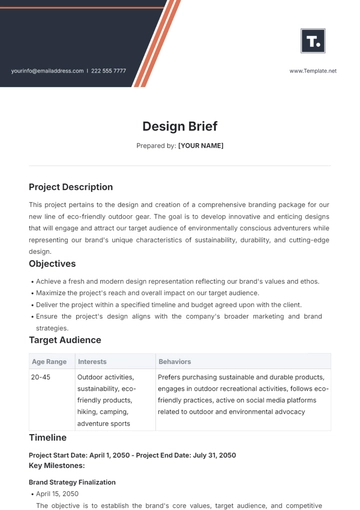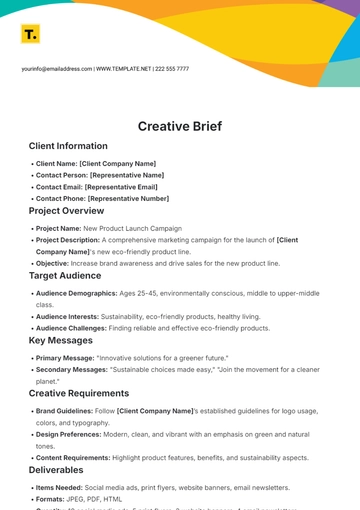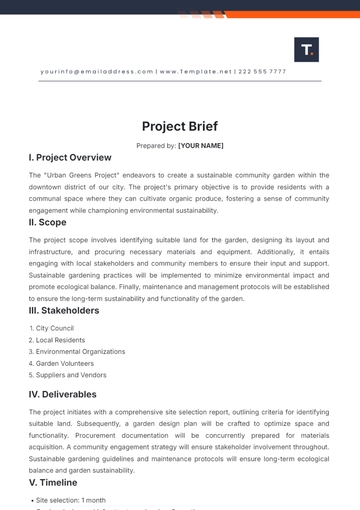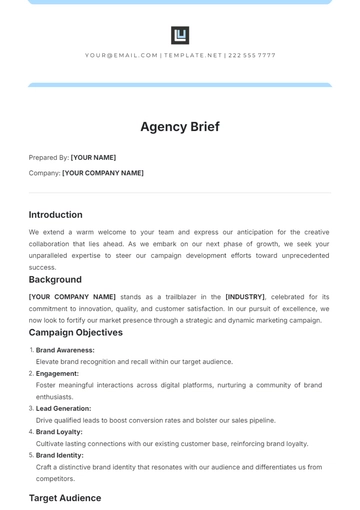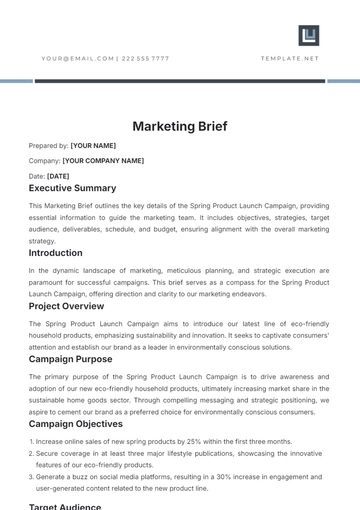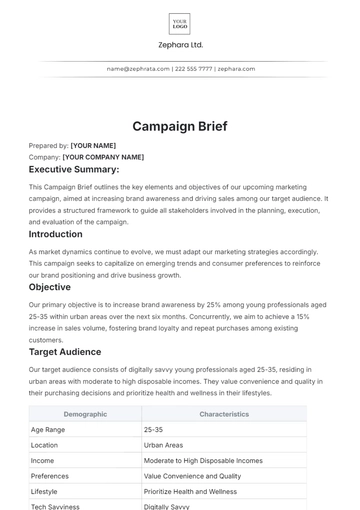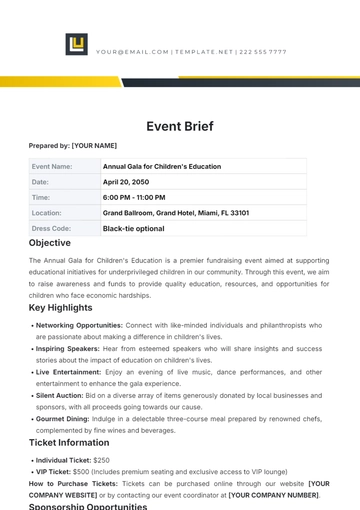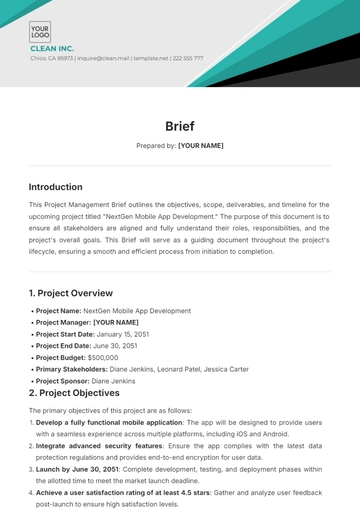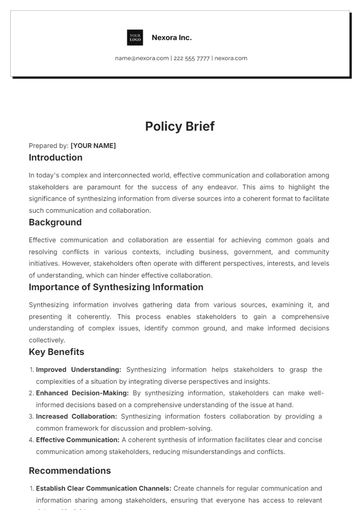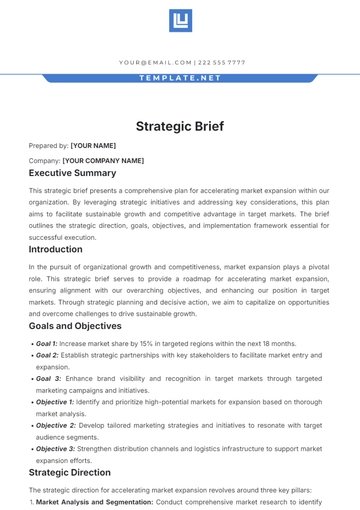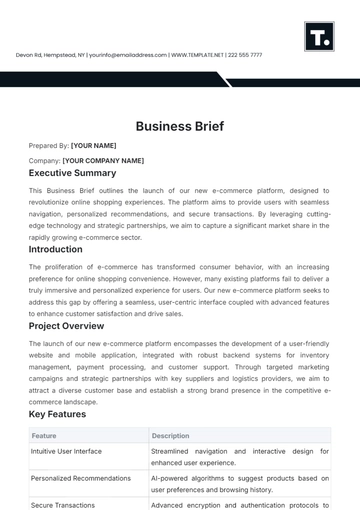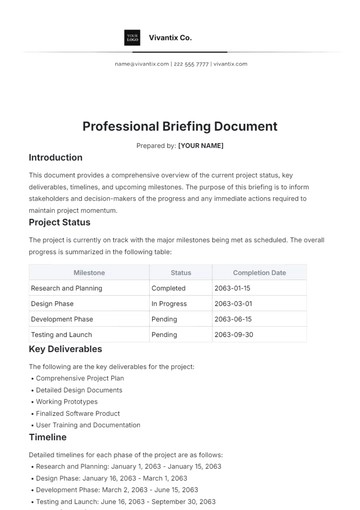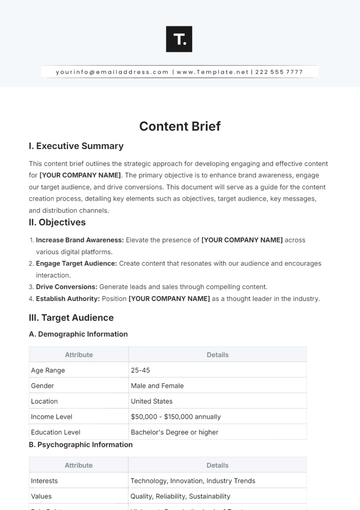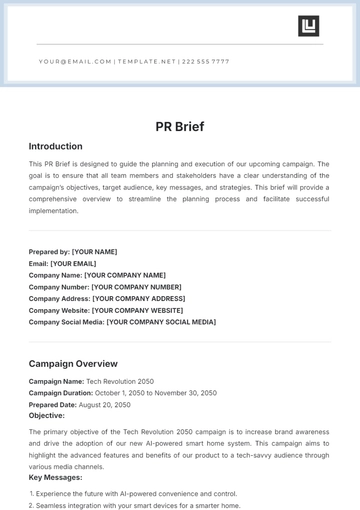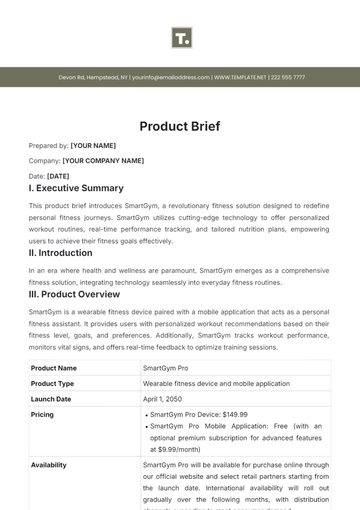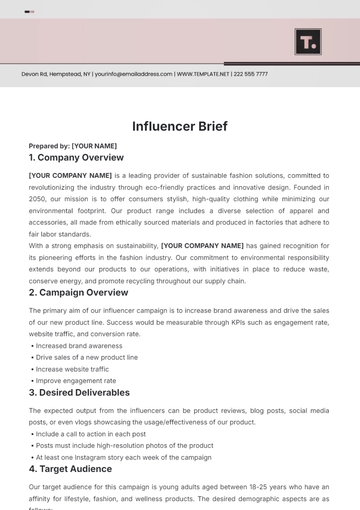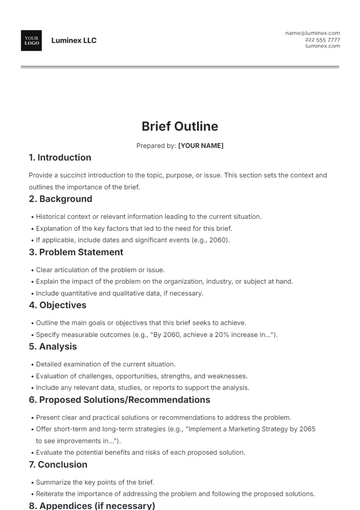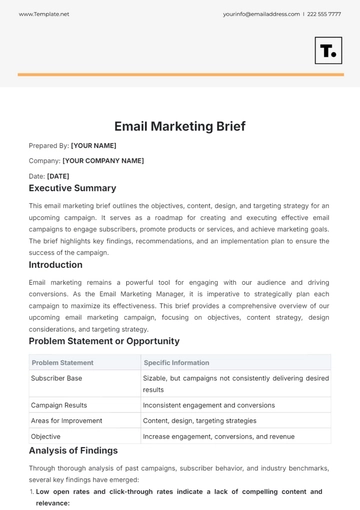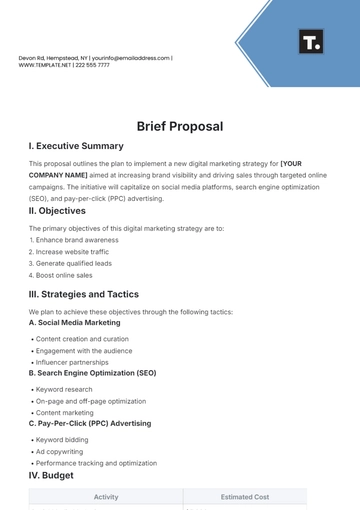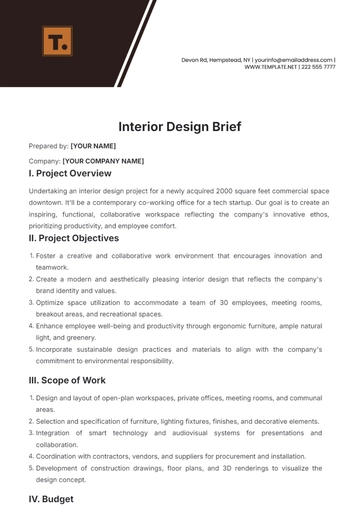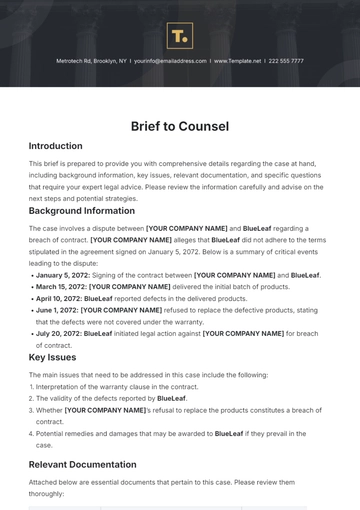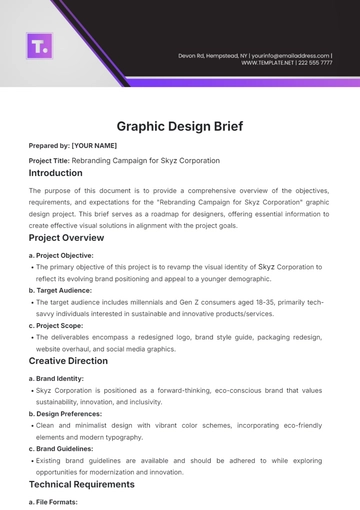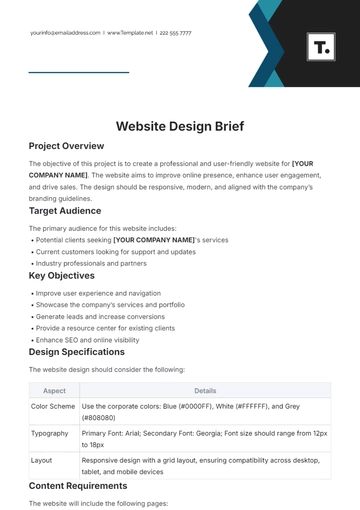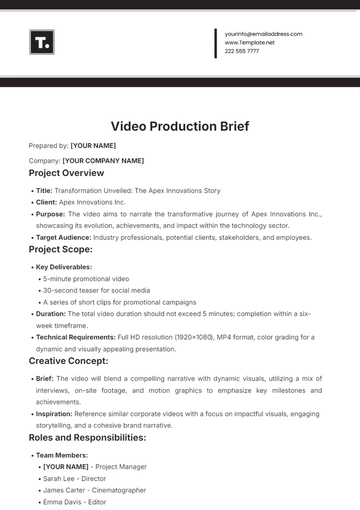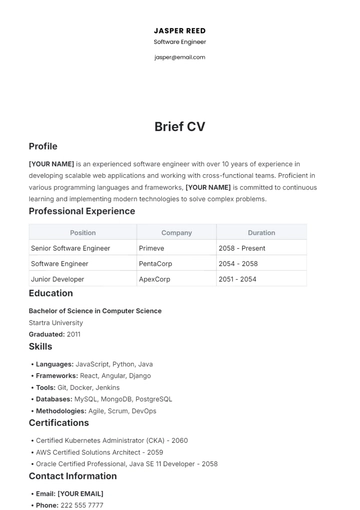Free Business Study Brief
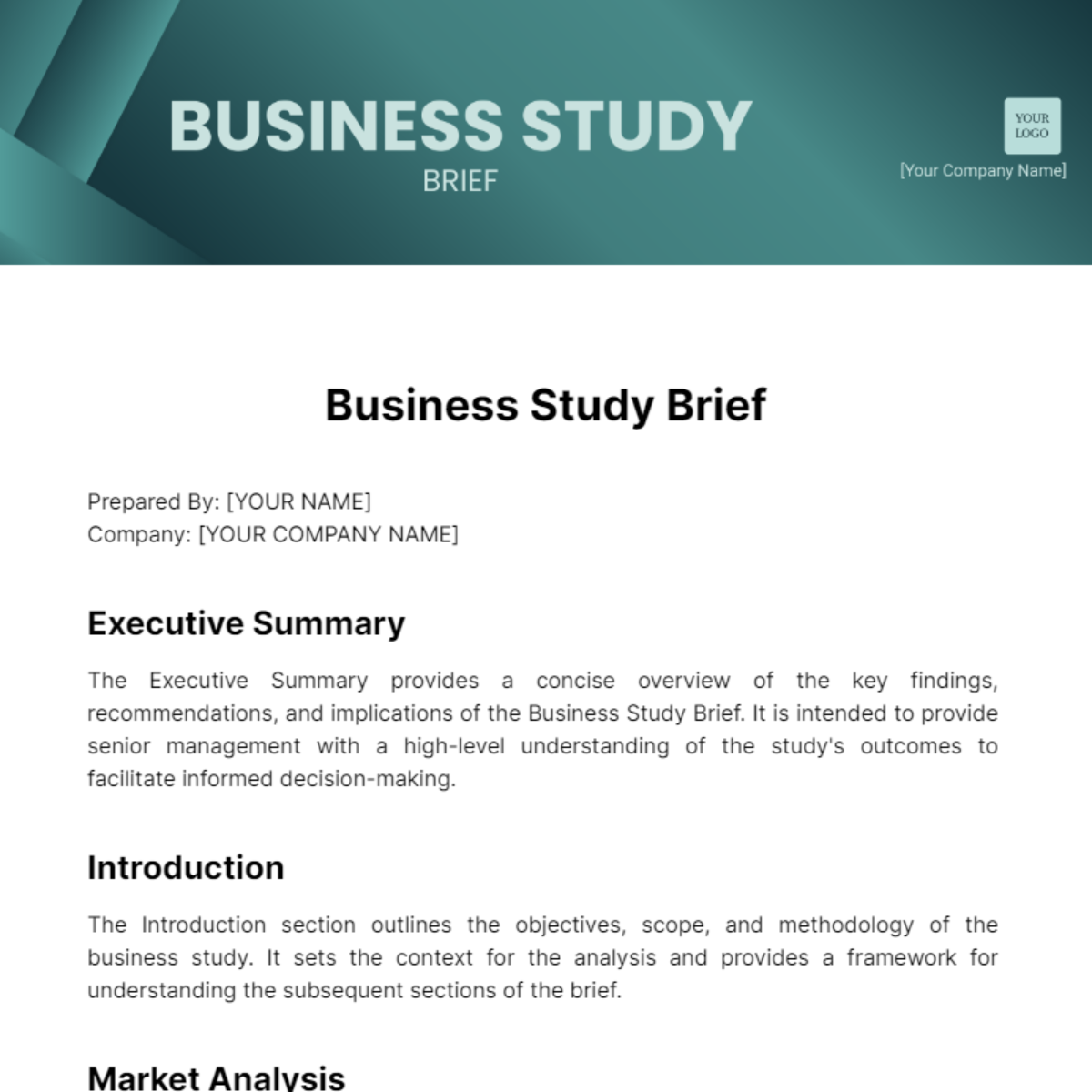
Prepared By: [YOUR NAME]
Company: [YOUR COMPANY NAME]
Executive Summary
The Executive Summary provides a concise overview of the key findings, recommendations, and implications of the Business Study Brief. It is intended to provide senior management with a high-level understanding of the study's outcomes to facilitate informed decision-making.
Introduction
The Introduction section outlines the objectives, scope, and methodology of the business study. It sets the context for the analysis and provides a framework for understanding the subsequent sections of the brief.
Market Analysis
The Market Analysis conducted for this business study delves into critical aspects of the external environment that impact the business's operations and growth prospects. Through rigorous examination of market trends, customer preferences, and competitive dynamics, the following insights have been gathered:
Market Trends: Analysis of prevailing market trends reveals shifting consumer behaviors and preferences, such as an increasing demand for sustainable products and digital services. Additionally, a growing emphasis on convenience and personalized experiences is observed, driving changes in purchasing patterns and market dynamics.
Customer Preferences: By scrutinizing customer preferences through surveys, focus groups, and data analysis, it's evident that there's a heightened desire for products/services that offer value, and innovation, and align with ethical and environmental considerations. Understanding these preferences is crucial for tailoring offerings and enhancing customer satisfaction and loyalty.
Competitive Dynamics: Examination of competitive forces highlights the presence of both traditional competitors and disruptive newcomers in the market landscape. Competitors are constantly innovating and expanding their offerings to capture market share, emphasizing the importance of differentiation and strategic positioning.
Growth Opportunities: Despite market challenges, several growth opportunities have been identified, particularly in emerging market segments or untapped demographics. Leveraging technological advancements, strategic partnerships, and market insights can unlock these opportunities and fuel expansion.
Market Positioning Strategies: Based on the analysis, strategic recommendations for market positioning include emphasizing unique value propositions, enhancing product/service differentiation, and implementing targeted marketing campaigns to resonate with specific customer segments. Furthermore, exploring niche markets or diversifying product offerings can strengthen the business's competitive advantage.
Feasibility Assessment
In conducting the feasibility assessment, several key factors were thoroughly analyzed to determine the viability and potential impact of proposed business initiatives, product launches, or market expansions. The assessment focused on the following areas:
Market Demand Analysis: A comprehensive examination of market demand was conducted to gauge the potential reception of new products or services. This analysis included studying consumer preferences, market trends, and competitor offerings to identify opportunities and potential challenges.
Resource Allocation and Investment Requirements: The feasibility assessment carefully considered the resources required for implementing proposed strategies, including financial investments, human capital, technology, and infrastructure needs. A cost-benefit analysis was conducted to evaluate the return on investment and assess the feasibility of resource allocation.
Risk Analysis and Mitigation Strategies: Potential risks and challenges associated with the proposed initiatives were identified and evaluated. This analysis encompassed market risks, operational risks, regulatory risks, and financial risks. Mitigation strategies were developed to address identified risks and enhance the feasibility of the proposed strategies.
Operational Capacity and Scalability: The assessment included an evaluation of the organization's operational capacity to support the implementation of new initiatives or expansions. Consideration was given to factors such as production capabilities, supply chain management, distribution channels, and scalability potential to ensure the feasibility of scaling up operations.
Regulatory and Legal Compliance: Compliance with regulatory requirements and legal considerations was thoroughly examined to assess the feasibility of proposed strategies. This included analyzing regulatory frameworks, industry standards, licensing requirements, and potential legal implications to ensure adherence to applicable laws and regulations.
Stakeholder Analysis and Alignment: The feasibility assessment involved identifying key stakeholders and assessing their interests, concerns, and potential impacts on proposed initiatives. Stakeholder engagement strategies were developed to foster alignment and support for the proposed strategies.
Operational Evaluation
The Operational Evaluation delves into the core operational aspects of the business, scrutinizing current strategies, processes, and operations to ascertain their effectiveness in achieving organizational goals. Through a systematic assessment, this section identifies areas ripe for improvement and optimization, aiming to bolster efficiency and overall performance.
Key components of the Operational Evaluation include:
Process Analysis: Thorough examination of existing processes across departments or functions to identify bottlenecks, inefficiencies, and redundancies. This involves mapping out workflows, analyzing resource utilization, and pinpointing areas where streamlining is warranted.
Performance Metrics Review: Evaluation of key performance indicators (KPIs) to gauge the effectiveness of operational activities. This entails comparing actual performance against established benchmarks, assessing trends over time, and identifying areas where performance falls short of expectations.
Resource Allocation Assessment: Analysis of resource allocation practices to ensure optimal utilization of human, financial, and technological resources. This involves assessing resource allocation against strategic priorities, identifying areas of overallocation or underutilization, and recommending realignment where necessary.
Technology Integration: Examination of the role of technology in driving operational efficiency and effectiveness. This includes assessing the suitability of existing technologies, identifying opportunities for automation or digitization, and evaluating the potential benefits of adopting new technologies or upgrading existing systems.
Risk Management: Evaluation of risk management practices to identify potential operational risks and vulnerabilities. This involves assessing the adequacy of risk mitigation strategies, analyzing past incidents or near-misses, and recommending enhancements to bolster resilience and continuity.
Stakeholder Engagement: Assessment of stakeholder engagement processes to ensure alignment and collaboration across internal and external stakeholders. This includes evaluating communication channels, feedback mechanisms, and collaboration tools to enhance transparency, accountability, and relationship management.
Financial Analysis
The Financial Analysis section provides a detailed examination of the financial health and profitability of the business. It encompasses various financial metrics and ratios to assess the company's performance and compare it against industry benchmarks. Key components of the Financial Analysis include:
Revenue Analysis: A breakdown of the company's revenue streams, including sources of revenue and trends over time. This analysis may include segmentation by product lines, customer segments, or geographical regions.
Cost Analysis: An evaluation of the company's cost structure, including both fixed and variable costs. This analysis helps identify areas of cost inefficiency and opportunities for cost optimization.
Profitability Analysis: Assessment of the company's profitability metrics, such as gross profit margin, operating profit margin, and net profit margin. These metrics provide insights into the company's ability to generate profits from its operation.
Financial Ratios: Calculation and interpretation of key financial ratios, including liquidity ratios (e.g., current ratio, quick ratio), solvency ratios (e.g., debt-to-equity ratio, interest coverage ratio), and profitability ratios (e.g., return on assets, return on equity). These ratios help gauge the company's financial health and performance relative to industry standards.
Cash Flow Analysis: Examination of the company's cash flow statement to assess its ability to generate cash from operating activities, invest in growth opportunities, and meet financial obligations. This analysis includes metrics such as cash flow from operations, investing activities, and financing activities.
Financial Performance Benchmarking: Comparison of the company's financial performance against industry peers and competitors. This benchmarking exercise helps identify areas of strength and weakness relative to industry standards and best practices.
Financial Forecasting: Projection of future financial performance based on historical trends, market conditions, and strategic initiatives. This forecasting helps management anticipate potential challenges and opportunities and develop informed financial strategies.
Recommendations
Investment in Market Research: Allocate resources towards ongoing market research efforts to stay abreast of evolving consumer preferences and market trends. This will enable the company to adapt quickly to changing market dynamics and identify emerging opportunities for growth.
Enhanced Product Development: Focus on innovation and product development initiatives to meet evolving customer needs and preferences. Prioritize research and development efforts to introduce new products or enhance existing offerings, thereby maintaining competitiveness in the market.
Expansion into New Markets: Explore opportunities for geographic expansion or market diversification to mitigate risks associated with reliance on a single market. Conduct thorough feasibility studies and market assessments to identify viable expansion opportunities and develop targeted entry strategies.
Optimization of Operational Processes: Implement process improvement initiatives to streamline operations and enhance efficiency across the organization. This may involve the adoption of technology solutions, automation of repetitive tasks, or restructuring of workflows to eliminate bottlenecks and reduce costs.
Investment in Employee Training and Development: Prioritize employee training and development programs to enhance skills and capabilities across the workforce. This will not only improve employee productivity and satisfaction but also foster a culture of continuous learning and innovation within the organization.
Strengthening Financial Management Practices: Implement robust financial management practices and controls to ensure transparency, accountability, and compliance with regulatory requirements. This includes regular financial reporting, budget monitoring, and risk management protocols to safeguard the company's financial health.
Strategic Partnerships and Alliances: Explore opportunities for strategic partnerships or alliances with complementary businesses to leverage synergies and drive mutual growth. Collaborate with industry peers, suppliers, or distributors to access new markets, technologies, or distribution channels.
Customer Relationship Management: Enhance customer relationship management processes to deepen customer engagement and loyalty. Invest in customer service training and adopt customer-centric approaches to better understand and address customer needs, thereby fostering long-term relationships and repeat business.
Sustainability Initiatives: Integrate sustainability initiatives into business operations to meet evolving societal expectations and mitigate environmental impacts. This may include adopting eco-friendly practices, reducing carbon footprint, or sourcing sustainable materials to align with corporate social responsibility goals.
Regular Performance Monitoring and Review: Establish mechanisms for regular performance monitoring and review to track the implementation of recommendations and measure progress toward strategic objectives. This will enable timely adjustments and course corrections to ensure alignment with business goals and objectives.
Conclusion
The Conclusion section summarizes the key findings and recommendations of the Business Study Brief. It reinforces the importance of the analysis in informing strategic decision-making and outlines the next steps for implementation.
- 100% Customizable, free editor
- Access 1 Million+ Templates, photo’s & graphics
- Download or share as a template
- Click and replace photos, graphics, text, backgrounds
- Resize, crop, AI write & more
- Access advanced editor
Introducing the Business Study Brief Template from Template.net: your go-to resource for comprehensive analysis. This customizable and editable template simplifies business study creation, ensuring accuracy and efficiency. With our Ai Editor Tool, effortlessly tailor every detail to meet your research needs. Simplify study preparation and elevate your business insights with ease, exclusively on Template.net.
